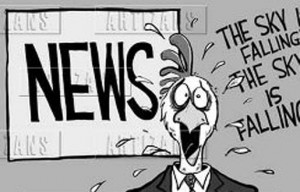 ELLIOTT D. POLLACK
ELLIOTT D. POLLACK
& Company
FOR IMMEDIATE RELEASE
February 16th, 2016
The Monday Morning Quarterback
A quick analysis of important economic data released over the past week
Late last week was, simply put, strange. I received 10 calls from media, politicians and businessmen wanting to know how severe the recession would be or if we were in a recession and so on. While the probabilities might have changed a little over the last month, the odds are still very much that we are not in a recession nor that one is imminent.
Slow growth? Sure. Slower than last year? Probably. But, for all of the Chicken Little followers out there, you are likely to be disappointed. The sky is most likely not falling. Let’s look at the data.
1. The stock market. The first economics text book I read was written by Paul Samuelson who was a renowned economist in the 60’s and 70’s. One of his most famous quotes was “the stock market predicted nine of the last five recessions.” In other words, the stock market has had too many instances of declines without a recession to be a good predictor. Given the current level of multiples, this could simply be a correction to more normal levels.
2. China. China accounts for less than 1% of U.S. GDP. Exports account for about 13% of economic activity and China accounts for about 8.4% of exports. So, it would take a serious decline in China to hurt us much. Is that in the cards? Probably not. China’s rate of growth slowed from about 10% in 2010 to about 7.3% in 2014. That’s still a rate of growth that’s more than twice the U.S. rate of growth. And because it is still growing so rapidly, the numbers work out as follows: growth (in dollar terms) in 2015 will be about the same as they were in 2012.
3. Manufacturing has been declining in the U.S. This is correct. New orders for manufactured goods are down. And the Purchasing Managers Index for ISM has been below levels associated with growth in manufacturing for the last four months. However, this indicator gave false signals in 2003, 2005, and 2012. In addition, the non-manufacturing index is still very positive. Keep in mind that manufacturing now accounts for less than 15% of economic activity, which is only a fraction of what services produces.
4. Inventories to sale ratios are out of line. This is also true. But, most of the excess appears to be in autos. Given the strength in auto sales, this should not be a prolonged problem. Keep in mind that the average age of the auto fleet is now 11.5 years. This is actually up from 2014 and way up from 2005. So, demand should remain strong.
5. The yield curve. Yields curves tend to invert (short term rates higher than long term rates) prior to a recession. That is not even close to the case now.
6. Employment and consumers. There is still good news on the employment front and consumers (who make up about 2/3 of the economy) appear to be in better shape than at any time since the recovery began.
Yes, the recovery is getting old compared to historic averages. But, expansions don’t die of old age. They die from imbalances in the economy that make an economy vulnerable to exogenous shocks or asset bubbles combined with a tightening in FED policy. These aren’t the current circumstances.
So, while the probabilities of a recession are higher today than they were several months ago, the odds still favor continued (albeit slower) growth. While Chicken Little will be right at some point, it is probably not now.
U.S. Snapshot:
The Blue Chip consensus forecast now suggests that the economy will grow by 2.1% in 2016. While this is weak relative to the past two years (2.4% growth), it is in line with the mediocrity of the rest of this recovery.
Retail sales in January were up 0.2% from December on a seasonally adjusted basis and were up 3.4% from January 2015.
Total manufacturing sales were down 0.6% in December and are now 2.7% below a year ago.
The University of Michigan consumer sentiment index fell to 90.7 in February. This is down from 92.0 in January and 95.4 a year ago.
Arizona Snapshot:
According to the Home Builders Association of Central Arizona, housing permits in the Greater Phoenix area were up over 44% in January 2016 compared to a year ago. Permits were 1,194 this year compared to 825 a year ago.
Total activity at Sky Harbor Airport was up 4.5% in 2015. This is despite a 0.7% decline in December.











